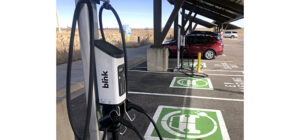It is critical to always remember to follow these best safety practices from when working on a hybrid and electric vehicle
Overland Park, Kan.—For most people, battery electric vehicles (BEVs) and plug-in hybrid electric vehicles (PHEVs) don’t spring to mind when they imagine a jump starting situation. But virtually every BEV and PHEV model on North American roads contains a low voltage (LV) battery in combination with the high voltage battery, states Clore Automotive in a new report, as explained below.
The way those batteries interact and how they handle various tasks within the electrical system can vary by propulsion type and by make/model, but the most important thing to know is that the LV battery is critical to the vehicle starting event and, if it is dead or in some way compromised, the vehicle will not start.
Essentially, the most sophisticated EVs on the road are just as dependent on the LV battery as an 1984 Chevrolet Caprice Classic. So, yes, someone can “brick” their Tesla Model S Plaid if the LV battery drops too low to be of use.
In some cases, the LV battery is needed to access the vehicle, get under the hood or open the trunk. This can present serious problems if the LV battery goes dead. For instance, how does a technician access the LV battery if they can’t pop the hood? Some manufacturers have built-in workarounds for these situations, as Clore Automotive notes below.
BEVs, PHEVs or ICE — Always Remember Safety
No matter the type of propulsion, it is critical to always remember to follow the best safety practices when working on the vehicle, especially when working on and around batteries and the electrical system. So, wear protective eyewear, remove rings and jewelry, take care not to drop a wrench or other metal object on the battery terminals, follow all manufacturer’s instructions related to jump starting procedures for the vehicle being serviced and pay close attention to polarity, in the vehicle and on whatever tool you use for jump starting. For techs who need a refresh on jump starting safety and basics, Clore published a recent article on this topic.
A Different Sort of Jump Starting
Clore clarifies that when jump starting LV batteries in most BEV and PHEV configurations, techs aren’t really jump starting in the way they are when performing this task on an ICE vehicle. On an ICE vehicle, when you jump start, you are supplying a spike of power to turn the starter and get the engine running, in place of the depleted vehicle starting battery. With BEVs and PHEVs, the jump starter is essentially augmenting the disabled/depleted LV battery, essentially raising system voltage enough to allow the start event to occur and fire up the high voltage battery and other systems. So, techs are still powering (jumping) the LV battery, but the nature of that jump is different.
If Available, Always Use Alternate Starting Points
Most techs learn to connect directly to the battery positive terminal when jump starting. This is almost second nature, though the jump starter negative clamp should always be connected to an engine or chassis ground. With BEVs and PHEVs, most vehicle manufacturers provide alternate starting points that allow techs to provide the power necessary to get the vehicle started but not interface directly with the vehicle’s LV battery.
Here are a few examples Clore has provided:
Tesla: Some Tesla models feature alternate starting points behind the front fender shroud. This is a great solution because it resolves the issue where a dead LV battery prevents the hood from being able to be opened.

On the Model 3, there are wires running to the back of the front tow hook cover, which, when accessed, allow the connection of a jump starter, which then provides the necessary power to open the hood.

Note: These wires are only for use in opening the hood when the LV battery is depleted. They should not be used to charge or jump start the LV battery.
Hyundai/Kia: Most Hyundai/Kia PHEV models incorporate a positive starting point within the fuse box, which typically is marked with a large “+” symbol, indicating the starting point is contained within it. Simply remove the fuse box cover to access the positive starting point (shown below). Usually, a tech can find a good grounding point for these vehicles on the electric motor, but it can vary model to model.

Ford Mustang Mach-E: For many Mach-E models, the alternate starting points are in the front driver’s side fender well. To access these points, techs are required to remove two plastic shrouds, but, once removed, the starting points are clearly marked and easily accessible.

In almost every case, alternate starting points are available and the manufacturer-recommended way to provide jump starting power to the LV battery. Consult the vehicle owner’s manual for the proper connection method and procedure for the specific vehicle.
The Jump Start Process is Familiar
Once a tech has identified the proper connection procedure for a vehicle, make the connections, remembering the proper connection sequence (same for all vehicle types): first, connect the positive jump starter lead to positive starting point and then connect the negative jump starter lead to a proper vehicle ground (engine, electric motor or chassis ground). Then, attempt to start the vehicle. Once started, disconnect the jump start in the opposite order from the connection process: first, remove the ground connection, then remove the positive connection, always taking care not to let the jump starter leads touch each other, a common connector or vehicle components.








Comments are closed.